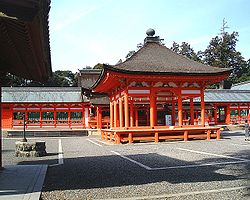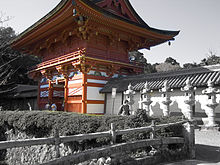- Nangū Taisha
-
Nangū Taisha
南宮大社
Nangū Taisha Information Founded Emperor Jimmu's reign (ca. 711 to 585 BCE) Address 1734-1 Miyashiromine
Tarui, Gifu Prefecture, JapanNangū Taisha (南宮大社) is a Shinto shrine located in the town of Tarui in Fuwa District, Gifu Prefecture, Japan.
History
The shrine was first built during Emperor Jimmu's reign, who lived from 711 BCE to 585 BCE.
During the nearby Battle of Sekigahara in 1600, the shrine was completely burnt to the ground and was not rebuilt until 1642, when Tokugawa Iemitsu led the construction efforts.[1]
In 1867, as a result of shinbutsu bunri, the Buddhist temple located on the shrine grounds was moved to a different location. That temple is now named Shinzen-in (真禅院) and is still located in Tarui.
This shrine was recorded in the Engishiki Jinmyōchō (延喜式神名帳), a book from the mid-10th century; at that time, the shrine was Mino Province's ichinomiya. In 1871, it was called Nangū Shrine (南宮神社 Nangū Jinja), but was promoted to a taisha (大社 grand shrine) in 1925. Its name was changed to Nangū Taisha after World War II to reflect its promotion.
See also
Notes
- ^ Nangū Taisha. Zenkoku Kaiun Jinja Bukkaku Guide. Accessed May 9, 2009.
Coordinates: 35°21′39.5″N 136°31′31.1″E / 35.360972°N 136.525306°E
Shinto shrine Shinto architecture Buildings - chōzuya or temizuya
- haiden
- heiden
- hokora
- honden / shinden / shōden
- kagura-den
- massha
- sessha
Architectonic elements Styles - hirairi-zukuri
- tsumairi-zukuri
- gongen-zukuri
- hachiman-zukuri
- hiyoshi-zukuri
- irimoya-zukuri
- ishi-no-ma-zukuri
- kasuga-zukuri
- kibitsu-zukuri
- misedana-zukuri
- nagare-zukuri
- ōtori-zukuri
- owari-zukuri
- ryōnagare-zukuri
- shinmei-zukuri
- sumiyoshi-zukuri
- taisha-zukuri
Others Implements Main kami Staff Head shrines1 - Fushimi Inari Taisha
- Usa Hachiman-gū
- Ise Grand Shrine
- Dazaifu Tenman-gū
- Munakata Taisha
- Suwa Taisha
- Hiyoshi Taisha
- Kumano Nachi Taisha
- Tsushima Shrine
- Yasaka Shrine
Miscellaneous 1 (in order of the size of the shrine network they head)
Categories:- Visitor attractions in Gifu Prefecture
- Shinto shrines in Gifu Prefecture
Wikimedia Foundation. 2010.

